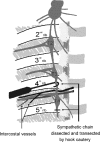Treatment of palmar hyperhidrosis: T(4) level compared with T(3) and T(2)
- PMID: 17667514
- PMCID: PMC1933552
- DOI: 10.1097/SLA.0b013e3180caa466
Treatment of palmar hyperhidrosis: T(4) level compared with T(3) and T(2)
Abstract
Objective: The aim of this study was to compare the outcomes of 3 different levels of sympathectomy.
Summary background data: Most surgeons still perform T(2) or T(2-3) sympathectomy for palmar hyperhidrosis, but both these treatments can cause severe side effects. Some recent articles have advocated T(4) sympathectomy and obtained satisfactory results.
Methods: Between January 2000 and August 2004, 234 records of patients treated for palmar hyperhidrosis were retrospectively reviewed. Of them, 86 patients were treated with endoscopic thoracic sympathectomy of T(2) (ETS(2)), 78 patients with ETS(3), and 70 patients with ETS(4). Follow-up data were collected using a telephone questionnaire with a scoring system. Multiple linear regressions were used to model markers for degree of satisfaction and severity of compensatory sweating (CS), including descriptive data, level of sympathectomy, clinical outcomes, and postoperative complications.
Results: Mean follow-up was 47.1 +/- 17.2 months. All 3 levels of sympathectomy could have achieved comparable improvement of palmar hyperhidrosis (P = 0.162). However, 88.5% of the patients noticed CS. Patients with ETS(4) presented the lowest incidence of CS (P = 0.030), had the least severity of CS (beta = -1.537, P = 0.002), and felt the least palmar overdryness (P < 0.001). None expressed regret for the procedure in the ETS(4) group (P = 0.022). Being obese did not increase the incidence of CS, but the severity of CS was directly related to body mass index (beta = 0.917, P < 0.001). The patients would be more satisfied if the severity of CS was minimal (beta = -0.185, P = 0.002). The degree of satisfaction may decrease with time (beta = -0.025, P = 0.003) and was lower when their palms were overdry (beta = -1.463, P < 0.001).
Conclusions: Different from the current procedure of T(2) or T(3) sympathectomy for palmar hyperhidrosis, T(4) sympathectomy would be a better and more effective procedure with minimal long-term complications.
Figures
Comment in
-
The appropriate level of sympathetic ablation for primary palmar hyperhidrosis.Ann Surg. 2008 Oct;248(4):687; author reply 687. doi: 10.1097/SLA.0b013e3181883cd2. Ann Surg. 2008. PMID: 18936584 No abstract available.
References
-
- Panhofer P, Zacherl J, Jakesz R, et al. Improved quality of life after sympathetic block for upper limb hyperhidrosis. Br J Surg. 2006;93:582–586. - PubMed
-
- Dewey TM, Herbert MA, Hill SL, et al. One-year follow-up after thoracoscopic sympathectomy for hyperhidrosis: outcomes and consequences. Ann Thorac Surg. 2006;81:1227–1232. - PubMed
-
- Yoon SH, Rim DC. The selective T3 sympathicotomy in patients with essential palmar hyperhidrosis. Acta Neurochir (Wien). 2003;145:467–471. - PubMed
-
- Yoon DH, Ha Y, Park YG, et al. Thoracoscopic limited T-3 sympathicotomy for primary hyperhidrosis: prevention for compensatory hyperhidrosis. J Neurosurg. 2003;99(1 suppl):39–43. - PubMed
-
- Lin CC, Telaranta T. Lin-Telaranta classification: the importance of different procedures for different indications in sympathetic surgery. Ann Chir Gynaecol. 2001;90:161–166. - PubMed
MeSH terms
LinkOut - more resources
Full Text Sources



